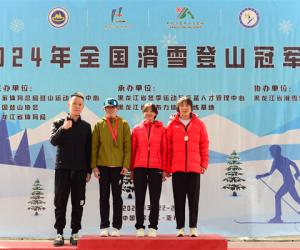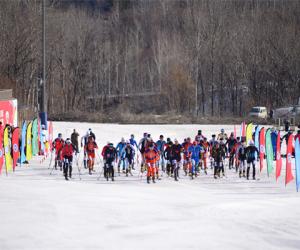
The former double-chair Larch lift at Lake Louise Mountain Resort was gone. In its place stood a new high-speed quad.
Local skier Ken Barraclough hit the lift line on opening day, eager to be among the first to test the improved transport. He couldn't understand why, with the expanded carrying capacity, the queue was snaking forward at a slug's pace. Finally reaching the head of the line, he discovered the reason.
“They were only letting people ride up on every third lift,” he says. “I asked why, and they said that Parks Canada didn't want the place to get overrun.”

Lake Louise, along with Mount Norquay and Sunshine Village, lies within Banff National Park. Up the road, SkiMarmot Basin occupies a spot in Jasper National Park. In these nature-preserved haunts, officials manage the land for wilderness and wildlife. Skiing here must not ruffle the skirts of Mother Nature.
Unlike most modern ski areas, Alberta's national park resorts are not real-estate developments with chairlifts attached. Instead of hotels, mini-mansions and slope-side shopping malls, base areas offer only day lodges and skier amenities.
In lieu of development, winter visitors are treated to Rocky Mountain views that made these parks a UNESCO World Heritage site. Glacier-sharpened peaks hem the skyline, and slopes plunge to deep river valleys. Only highways and a handful of communities interrupt the back-of-beyond aura.
Inside the park's towns, you'll find lodging equal to the best slope-side properties elsewhere. The railroad-built Banff Springs Hotel, Chateau Lake Louise and Jasper Park Lodge remain as luxurious Fairmont resorts. Other accommodations range from economical to opulent. A plethora of restaurants, spas and shops rounds out the experience. Best of all, winter crowds are rare and prices reasonable.
“We have the capacity for 4million visitors in the summertime. It takes a lot to fill that in the winter,” says Lisa Vinderskov of Canadian Rocky Mountain Resorts. “We're really the only ski destination in North America that goes on sale in the wintertime.”
Mount Norquay

The closest ski area to Banff is Mount Norquay, a four-mile climb from downtown. The operation dates to 1926, making it one of Canada's oldest ski areas, and its first double chair still services the original hard-core terrain.
This is a tiny, locals-style resort with only four lifts and 190 skiable acres with terrain varying from the wide groomers to double-black plungers. Steep and cheap, it's the sort of place where workers grab runs between shifts. The ticket window even sells lift tickets in timed increments.

For the vacationer, Norquay provides a perfect warm-up destination. Here, fresh-from-the-flight arrivals can muscle up a few conditioning runs before seriously exercising platinum cards in downtown Banff.
If they wanted to, Norquay skiers could practically plan their spending sprees from slopes, which overlook the town of Banff and the Bow Valley. Beyond rise massive, awe-inspiring peaks. The mountains here tower close, and nature seems intimate.
“My groomer guys will see wolves at night,” says general manager Andre Quenneville. “We get the bighorn sheep coming up and down the road. It's kind of neat that way. This is truly an untouched and underdeveloped area that allows you to get a feel for traditional skiing.”
Sunshine Village
Located five miles up the road from Banff, Sunshine Village features a base area that's not at the area's base. Instead, an eight-passenger gondola transports you more than three miles up – from the parking lot to an amenity-packed, mid-mountain village.

In 1928, the Canadian Pacific Railway built a log lodge here for horse trekkers. That original structure has since become a pub, with overnight guests now housed in the 1960s-vintage 84-room Sunshine Mountain Lodge. It remains Banff's only ski-in/ski-out accommodation.
Sunshine features 3,358 acres spread across three mountains. With much of that terrain above the timberline, the area renders a yodel-inducing European feel.
Like groomed slopes? You'll find mega-miles of soft corduroy. For freestylers, the eight-acre Rogers Terrain Park comes with enough boxes, rails and jumps to ensure local orthopedic surgeons never miss a BMW payment. Warren Miller wannabes have the Delirium Dive where all must wear avalanche beacons, carry shovels and travel with buddies. Just dropping in requires negotiating the 20-foot cliff that crowns its top. It's not terrain for the timid.
“There's a legendary skier who comes from Saskatchewan every year,” says Sunshine spokesman Doug Firby. “We call him Trapper Jerry. For his 90th birthday, he skied Delirium Dive. I think he still does it every year on his birthday. Of course, we surround him with Sunshine staff just to make sure that he makes it OK.”
Lake Louise
The European feel continues 36 miles up the Trans-Canada Highway from Banff at Chateau Lake Louise where bellmen and doormen don alpine-style knickers. The attire dates to the late 1800s when the Canadian Pacific Railway first imported Swiss guides to introduce well-heeled travelers to Alberta's rugged Rockies. Skiing arrived in the 1930s.
At 4,200 acres, today's Lake Louise Mountain Resort offers the most lift-served terrain in Banff National Park. Its topography features a smorgasbord of bowls, chutes, glades, gullies and groomers. Every chairlift sports at least one easy run down, ensuring that families and friends of varying abilities can ride cheek-to-cheek up the lifts together.
From a high vantage point, visitors can look across the valley and see the castle-like Chateau rising beside Lake Louise, its famed blue-green surface frozen white in the depths of winter. Below, timber-lined trails seem to aim straight toward towering peaks. Animal tracks frequently dot the neighboring snow.
“In the summertime, we're one of the natural three corridors for grizzly bears,” says Lake Louise sales manager Jacqueline Birk. “We run the gondola, which is really nice because you get to see live grizzly bears right on the front face of the mountain.”
Fortunately for skiers and snowboarders, she insists those burly bruins spend the winter hibernating.
Marmot Basin
Jasper National Park lies north of Banff, a 142-mile drive from Lake Louise up the glacier-studded Icefields Parkway. Less visited and lower key than its southern cousin, Jasper is the park for those wanting more “away” in a winter getaway.
Ski Marmot Basin is 12 miles south of the town of Jasper. Compact rather than sprawling, the resort's 1,675 acres feature ample terrain for skiers and riders of all abilities.
Where the Banff triplets feature close-in peaks, Marmot overlooks the Athabasca River valley, which gives a more open feel to the vast topography. From its highest slopes, downhillers can gaze across the dark void and see jutting walls of snow-plastered peaks.
In this untrammeled landscape, wildlife abounds. Deer and elk wander through town while coyotes, bighorn and the occasional lynx saunter beside roadways. The nearby peaks house packs of wolves.
“There's a fellow who runs a company – he's called Alpine Art – and he'll take you on a guided tour to Pyramid Lake at nighttime,” says Marmot vice president Brian Rode. “You walk the trail while he talks about the flora and geology. Then he'll say, ‘Let's howl for wolves.' You'll howl. They'll howl back. It's a spooky experience.”
In these nature-preserved haunts, wailing at wolves is just another way of admiring the unruffled skirts of Mother Nature.











